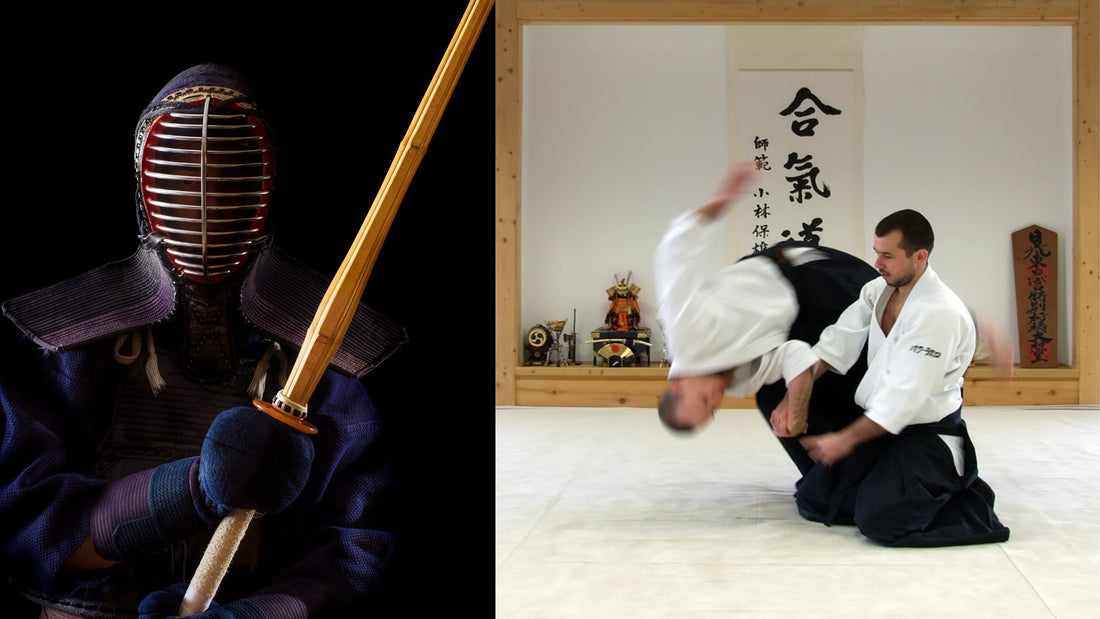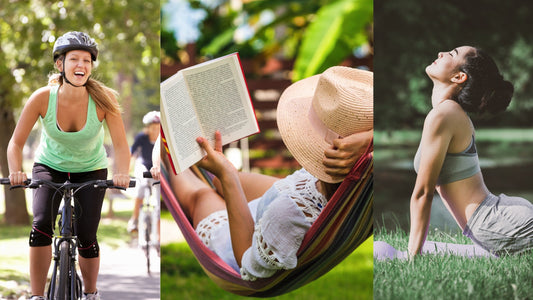When we think of "moving," we often think of sweating. Running, jumping, tensing... They're useful, sure. But is that really the kind of movement that feels good? The kind that calms the mind, anchors us in the present moment, and awakens the body without exhausting it?
In Japan, the relationship with movement is often gentler, more rooted in the philosophy of daily life. We don't move against ourselves, we move with ourselves. And sometimes even... with others.
Today, we invite you to discover three very different Japanese practices: one comes from martial arts and seeks harmony in confrontation, another shapes rigor through the sword, and the last offers you a morning gym session in your pajamas (yes, it's completely socially accepted). These practices may seem far removed from each other, but they share a common spirit: the desire to restore meaning and awareness to our gestures.
You don't need to be a ninja, a samurai, or a yoga teacher. Just a little curiosity... and maybe a desire to stand a little straighter tomorrow morning.
1 | Aikido – Harmony in Movement
The word Aikido is written as合気道.
- ai ( ai ): union, harmony
- ki : energy, vital breath
- 道 ( dō ): the way, the path
So, we could translate “aikido” as “the path of harmonizing energies.” A wonderful promise. But what does that actually mean?
Aikido is a Japanese martial art founded in the 1920s by Morihei Ueshiba (1883–1969), often referred to as O Sensei, “the great master.” After years of training in jujutsu, kenjutsu (swordsmanship), and other martial arts, Ueshiba came to a startling conclusion: true power lies not in domination, but in harmonization. One is no longer there to defeat the other, but to neutralize aggression… without feeding it.
Aikido is based on circular, fluid movements that redirect the opponent's energy without seeking confrontation. There is no competition or duel: the practice is done in pairs, in a spirit of cooperation. Each participant takes turns playing the role of attacker and defender. And we often emerge... relaxed, refocused, sometimes even a little overwhelmed. Because it's a martial art that works both the body and the mind.
This is also why aikido is sometimes nicknamed “ meditation in movement ”.

Why is it good for your ikigai?
Aikido is the art of saying “no” without violence, of remaining centered in the face of a storm, and of transforming aggression into dance. In other words: a useful skill for traffic jams, tense meetings, or romantic arguments.
Practicing aikido can help with stress management, improving posture, strengthening body awareness, and developing a true philosophy of life. Not bad for an art without punches.
Where to practice aikido in Quebec and Canada?
Good news: Aikido has spread across Canada. Here are some well-known dojos:
- Aïkido de la Montagne , Montreal – one of the oldest in Quebec. Website: https://www.aikidomontreal.com
- Aïkido Québec , Quebec – affiliated with Aïkikai Hombu Dojo in Japan. Website: https://www.aikidoquebec.com
-
Canadian Aikido Federation , to find other centers in Canada: https://www.canadianaikidofederation.ca
2 | Kendō – The sword as a mirror of oneself
If there's one art that immediately brings to mind the samurai, it's kendo. And yet, far from the dramatic duels of sword films, this discipline is today a profoundly modern martial art, focused on rigor, posture, and... inner work. Yes, even when you're wearing armor and shouting very loudly while striking.
A Brief, Sharp History
Kendō (剣道) literally means “the way of the sword”:
- 剣 ( ken ) = saber
- 道 ( dō ) = the way
Its origins lie in the samurai sword fighting techniques ( kenjutsu ), codified as early as the 12th century. Over time, these techniques were refined, and after the Edo period (1603–1868) they were transformed into a practice that was more spiritual and educational than warlike. Modern kendō, as we know it today, took shape in the early 20th century with the creation of specific equipment: a bamboo sword ( shinai ), protective armor ( bōgu )… and a good dose of discipline.
The cry you make when striking is called the kiai . It is not there to scare (even if it is a bonus), but to express your inner energy , your presence, your intention.
A book that we really enjoyed and that we recommend: The Stone and the Sword by Eiji Yoshikawa, we talk about it in this article .

Kendō and Ikigai: Standing, Sword or Not
At first glance, kendo may seem very martial, very "warlike." But in reality, it's less about beating an opponent than about confronting oneself . It's a school of rigor, patience, and inner silence. Holding your sword means holding your line. Keeping your distance means staying calm. Moving forward, even in fear, means learning to trust yourself.
In a society where we often seek to flee conflict or to endure it, kendo teaches the courage to be present , upright, and grounded.
It's not about winning, it's about progress—blow by blow, breath by breath.
And between us… there’s something powerfully liberating about punching a chest protector while yelling “MEN!” (head) or “KOTE!” (wrist), especially after a long day.
Where to practice kendo in Quebec?
Kendo is alive and well in Canada, with several dynamic clubs:
- Kendo Québec (Quebec City), a serious and accessible club. Website: https://www.kendoquebec.ca
- Kenshinkai Montreal – Reference center for traditional kendo. Website: https://www.kenshinkai.net
- Canadian Kendo Federation – To locate a club near you: https://kendo-canada.com
If you want to see what a top-level fight looks like, check out this championship match on the official channel of the All Japan Kendo Federation: All Japan Kendo Championship – YouTube
3. Radio Taiso – Japanese Morning Gym
Thought morning gymnastics was just for retirees at summer camps or forgotten VHS videos? Think again. In Japan, every day for nearly 100 years, millions of people—children, factory workers, office workers, retirees—have started their day with a routine of gentle but rhythmic movements known as Radio Taiso .
And believe it or not, this little morning ritual might just wake up not only your body… but your will to live.
What is Radio Taiso?
Radio Taiso (ラジオ体操) literally translates to “radio gymnastics.” It was founded in 1928, inspired by American “calisthenics” exercises broadcast over the radio. The idea? To offer the entire population a short, simple, and regular session of physical activity.
There are two main versions, “Radio Taiso 1” and “Radio Taiso 2” (yes, they didn't go to great lengths to name them). The first is softer and more accessible to everyone, the second a bit more physical.
Each session lasts between 3 and 5 minutes , with a series of very specific movements—stretching, bending, rotating—performed to music and often in groups, in public squares, in schools or at work. And yes, it's always broadcast on the radio... and even on television!
Radio Taiso and Ikigai: 5 minutes that change a day
In a society where we are running after time, where we often “put off” sport until tomorrow (or the day after), Radio Taiso is the perfect example of the small daily gesture that makes a big difference .
No equipment required. No heroic motivation required. Just a little music, a little space (in your living room or on a balcony), and the desire to stretch your body.
It's also a form of collective ritual : we move together, we take care of ourselves... together. And that's deeply Japanese. In fact, many Japanese companies and schools incorporate it into the start of the day, not only for health reasons, but also to create a sense of cohesion.

And if you're looking for a gentle way to start moving (or getting back into it), this is a wonderful gateway.
Where to practice Radio Taiso in Quebec?
- Radio Taiso isn't very widespread here yet... but it's starting to catch on! Some ideas:
- Maison de la culture du Japon in Montreal : sometimes offers discovery workshops (look out for them in their programming).
- Yoga or tai chi centers : Some include similar practices in their mindful movement classes.
- At home, of course! Official videos are available with simple instructions. For example: Radio Taiso in the original version (with visual instructions)
You can also make it a family or colleague ritual to start the day with a smile. Yes, even in slippers.
And you, what movement is calling you today?
Whether you are tempted by the defensive grace of Aikido, the sharp elegance of Kendō or simply the joyful stretches of Radio Taiso, one thing is certain: moving with meaning is already cultivating your ikigai .
You don't need to be a black belt or live in a dojo at the foot of Mount Fuji to get started. One step at a time, one gesture at a time—what matters is finding pleasure, presence, and a touch of curiosity .
At Ikigai Box , we believe that discovering an art, whether martial, creative, or meditative, is a key to reconnecting with yourself. That's why we're preparing content, ideas, and sometimes even gentle challenges for you to try in your daily life.
👉 Want to receive our inspirations, guides, and Japanese finds in your inbox? Subscribe to our newsletter right here. We promise it's one email per week and no more. You can unsubscribe at any time.
You'll find invitations to move, create, breathe... and sometimes, laugh a little too. Because, after all, happiness is also a question of movement.




